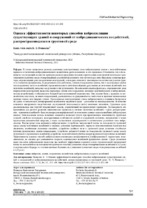Оценка эффективности некоторых способов виброизоляции существующих зданий и сооружений от вибродинамических воздействий, распространяющихся в грунтовой среде
Another Title
Evaluation of Effectiveness on Some Vibration Isolation Methods for Existing Buildings and Structures from Vibrodynamic Effects, Propagating in Soil Environment
Bibliographic entry
Повколас, К. Э. Оценка эффективности некоторых способов виброизоляции существующих зданий и сооружений от вибродинамических воздействий, распространяющихся в грунтовой среде = Evaluation of Effectiveness on Some Vibration Isolation Methods for Existing Buildings and Structures from Vibrodynamic Effects, Propagating in Soil Environment / К. Э. Повколас // Наука и техника. – 2023. – № 2. – С. 131-140.
Abstract
В статье приводятся расчеты различных конструктивных схем виброизоляции здания с железобетонным каркасом от источника вибродинамического воздействия, расположенного за его пределами. Отмечается, что в большинстве исследований в качестве критерия риска повреждения несущих строительных конструкций используют максимальную величину скорости вертикальных колебаний фундамента или грунта перед ним. Выделены основные факторы, определяющие риск повреждения конструкций, к которым относятся: инженерно-геологические условия грунта в основании фундаментов, подвергающихся воздействию, степень повреждения здания, тип и конструкция здания или сооружения, частота колебаний, продолжительность действия вибрации, расстояние до источника колебаний, вид источника колебаний, материал сооружения и тип фундамента. На основании анализа факторов, определяющих риск повреждения конструкций, выделены параметры здания или сооружения, наименее чувствительного к вибродинамическим воздействиям и обладающего большей эксплуатационной надежностью. Оно должно быть с каркасом из железобетона или стали, не иметь повреждений, располагаться на фундаментах из свай-стоек в прочных маловлажных крупных песках или твердых глинах. Предлагаемые конструктивные схемы виброизоляции в основном базируются на одном из механизмов демпфирования колебаний в грунтовой среде – рассеянии на неоднородностях. В качестве основного инструмента теоретических исследований использовался метод конечных элементов. Грунтовая среда рассматривалась как упругий инерционный массив, ограниченный неотражающими границами. Достоверность его применения для расчета развития динамических процессов в системе «источник колебаний – среда распространения – приемник колебаний» была подтверждена верификацией на основании данных маломасштабных лабораторных опытов. Использование метода конечных элементов позволяет учесть пространственную изменчивость грунтовых условий, свойства материалов, конструктивные особенности зданий и сооружений, величину, направление и точку приложения динамической нагрузки, а также осуществлять моделирование и оптимизацию различных схем виброзащиты. Рассмотрены семь вариантов виброизоляции: устройство инерционной плиты на поверхности грунтовой среды между источником колебаний и зданием, установка вертикального экрана из газонаполненных баллонов под давлением, комбинация указанных способов, устройство свайного поля в грунтовой среде, усиление столбчатых плитных фундаментов здания микросваями, устройство ребристой плиты на поверхности грунтовой среды между источником и приемником колебаний, устройство железобетонной обоймы вокруг фундамента-источника колебаний. Эффективность каждого способа виброизоляции оценивалась коэффициентом демпфирования К, параметром, показывающим, во сколько раз уменьшается скорость вертикальных колебаний фундамента здания. Среди указанных выше способов виброизоляции выделены два наиболее эффективных варианта в виде горизонтальной инерционной плиты из железобетона на поверхности грунтового массива (снижение скорости вертикальных колебаний в 4,5 раза) и вертикального барьера из газонаполненных баллонов под давлением (снижение скорости вертикальных колебаний в 3,32 раза).
Abstract in another language
The paper presents calculations of various design schemes for vibration isolation of a building with a reinforced concrete frame from a source of vibrodynamic exposure located outside it. It is noted that in most studies, the maximum value of the velocity of vertical vibrations of the foundation or soil in front of it is used as a criterion for the risk of damage to loadbearing building structures. The main factors that determine the risk of damage to structures are identified. These include the engineering and geological conditions of the soil at the base of the affected foundations, the degree of damage to the building, the type and design of the building or structure, the vibration frequency, the duration of the vibration, the distance to the vibration source, the type of vibration source, the material of the structure and the type of foundation. Based on the analysis of factors that determine the risk of damage to structures, the parameters of a building or structure that are least sensitive to vibrodynamic effects and have greater operational reliability are identified. It should be with a frame made of reinforced concrete or steel, not damaged, located on foundations of pile-racks in strong, low-moisture coarse sands or hard clays. The proposed design schemes for vibration isolation are mainly based on one of the vibration damping mechanisms in the soil medium – scattering on inhomogeneities. The finite element method has been used as the main tool for theoretical research. The ground medium has been considered as an elastic inertial array bounded by non-reflecting boundaries. The reliability of its application for calculating the development of dynamic processes in the system “oscillation source – propagation medium – oscillation receiver” has been confirmed by verification based on data from small-scale laboratory experiments. The use of the finite element method (FEM) makes it possible to take into account the spatial variability of soil conditions, the properties of materials, the design features of buildings and structures, the magnitude, direction and point of application of the dynamic load, as well as to model and optimize various vibration protection schemes. Seven variants of vibration isolation have been considered: the device of an inertial slab on the surface of the soil medium between the vibration source and the building, the installation of a vertical screen from gas-filled cylinders under pressure, a combination of these methods, the installation of a pile field in the soil medium, the reinforcement of the columnar slab foundations of the building with micropiles, the installation of a ribbed slab on the surface soil environment between the source and receiver of oscillations, the device of a reinforced concrete cage around the foundation-source of oscillations. The effectiveness of each method of vibration isolation has been evaluated by the damping coefficient K, a parameter showing how many times the speed of vertical oscillations of the building foundation decreases. Among the above methods of vibration isolation, two most effective options have been identified: in the form of a horizontal inertial slab of reinforced concrete on the surface of a soil mass (4.5-fold reduction in the rate of vertical vibrations), and a vertical barrier made of pressurized gas-filled cylinders (reduction in the rate of vertical vibrations by 3.32 times).
View/
Collections
- № 2[11]

